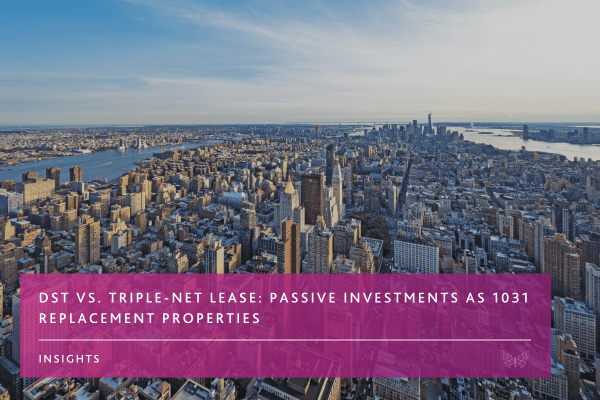If you’re looking to exchange into a less-active investment with steady income, here are some of the major pros and cons of these two options.
Property owners often look to perform 1031 exchanges as they enter retirement, seeking a transition from actively-managed residential or commercial properties to investments that generate passive income. Performing a like-kind exchange into another property type can allow them to defer capital gains taxes that would cut into their investment capital if they executed a taxable sale to convert to more liquid investments.
Because the definition of like-kind is broad and encompasses many types of property, exchangers have options when it comes to selecting replacement properties. In particular, there are two types of properties that are popular with those seeking passive income. Understanding how they work could make a big difference for those in need of security as they get older.
What is a triple-net lease?
A net lease is a type of lease in which the terms assign greater responsibility to the tenant than typical leases. There are single, double, and triple-net leases, and each one requires the tenant to assume more management responsibilities.
Under a triple-net lease, the tenant must pay 100% of the property taxes, insurance premiums, and maintenance costs for the property. Rent is usually lower to make up for these costs. For property owners, no longer having to deal with building maintenance (including plumbing, electrical, HVAC, parking lots, etc.) is an advantage, and ideal for retirees who want less-active investments.
Unlike many other commercial properties, NNN properties are generally single-tenant and have longer lease terms, often 10-20 years with multiple five-year renewal options and built-in rent increases, so there’s less worry about renegotiating rent or finding new tenants due to unexpected vacancies.
A subset of the triple-net lease is a bondable net lease, where the tenant cannot break the lease before its expiration date. This security can be very attractive to those looking for passive investments, as not only will the tenant be required to cover maintenance, but the property owner won’t have to worry about the stress of losing income during vacant periods.
While the security of a long-term tenant and steady income without active management can be attractive, there are some risks. If property values rise drastically, you may find your previously-negotiated rent increases inadequate. When you want to sell, the tenant may have right of first refusal, or even an agreed-upon price in some leases, meaning you may not be able to get the price you could have on the open market.
The key in those scenarios is to understand the exact lease terms, as not all NNN leases are the same. It’s also important to know your tenant. Since maintenance will be the tenant’s responsibility, you need to trust this tenant will not only pay their rent reliably, but can keep up with repairs.
Many triple-net tenants are large retailers that make changes to the space to fit their specifications. If the tenant vacates, you may be on the hook for whatever changes will be necessary to return the space to something a different tenant can use.
This type of uncertainty can make some hesitant to pursue a 1031 exchange into a triple-net property, especially if they fear they’ll be unable to find a tenant who will agree to a true triple-net lease that alleviates the property owner’s responsibilities. For those seeking passivity with less risk, there is another option worth considering.
What is a DST?
A Delaware Statutory Trust (DST) is an investment vehicle where investors’ money is pooled to acquire large-scale commercial properties (sometimes a single property, sometimes multiple properties) managed by a professional property manager.
Investors receive distributions from the rental income generated by the properties in the portfolio, but don’t have to collect that rent themselves or even acquire the properties. This makes the income truly passive, unlike with NNN properties where some management duties are still required. The property manager takes care of these things in a DST so investors don’t have to.
There are many types of DSTs targeting different sectors and investing in different numbers of properties. As Simon Brower, CEO of Upstream 1031, said at a recent webinar, “There’s a DST in pretty much every property type.” You can likely find a DST to match whatever specific industry or location you’re looking to target.
An interest in a DST can be used as a 1031 replacement property and offers specific advantages for exchangers. The properties have already been vetted by the DST manager, and aren’t in danger of falling through in a competitive market. The exchange therefore has a greater chance of success and can be completed quickly, which is why many exchangers use DSTs as backup options among their identified replacement properties.
One disadvantage of a DST is its lack of liquidity. Unless you can find a buyer for your interest in the DST, you won’t be able to sell until the end of the holding period. But when that holding period ends, the manager may offer to help you exchange into another DST, making a subsequent 1031 exchange simpler. There are also DSTs that convert investors’ interests into shares of a REIT that is more liquid in a process called a 721 upREIT exchange.
Another difference between a DST and a whole property is the low cost of entry. Some DSTs have low minimum investment amounts, allowing 1031 exchangers to diversify by exchanging into multiple DSTs. It’s therefore possible to exchange from one whole property into a series of DSTs, each with multiple properties. Any debt is non-recourse, meaning it is taken on by the trust, not the investors, lowering the risk for the individual.
The diversification of a DST can be important to those who want to maintain the value of their investments. While a whole property can greatly increase in value over time, it can also decrease in value depending on the market. DSTs have been seen as a smart hedge against inflation because of their diverse investments in sectors that have historically thrived in down economies. Retirees may be more concerned with steady income and maintaining value than with growth, which DSTs can offer.
By investing in multiple DSTs, estate planning can be simplified as heirs won’t have to manage or make decisions about a single property together. Instead, each may inherit one or more of the DST interests while still enjoying the same step up in basis that they would with a whole property.
The one thing you don’t get with DST is control. You won’t get to make the decisions on what is done with the portfolio properties, and it may be more difficult to sell your DST interest during the holding period than it would be to sell a whole property, causing you to miss out on opportunities. But for those entering retirement, this may be seen as a good thing, as they’re looking for a less hands-on investment.
Deciding between a DST and a NNN property
When choosing between a DST and a triple-net property, there is no one right answer. Both have pros and cons that may matter more to different investors.
Pros of a triple-net lease:
- Choose exactly which property you want to acquire, unlike a DST where you’re electing to invest in an already-chosen portfolio.
- Can sell the property whenever you want, borrow against the equity, or use it as collateral.
- No DST-related fees.
Cons of a NNN lease:
- A property is not by nature a triple-net property until you find a tenant that will agree to your lease terms. You have to find that tenant, negotiate the lease, and trust they’ll abide by the terms.
- There is always the risk the tenant will vacate, forcing you to find new tenants and absorb costs. Because a NNN property is a single high-value investment (as opposed to a diversified series of low-minimum DSTs), the loss of income from a single vacant property could majorly affect your retirement income.
- You have to find and acquire this property yourself, which can be stressful in a competitive market. If the property falls through, you could be in danger of a failed exchange, if no additional backup properties were identified.
Pros of a DST:
- Access to institutional-quality real estate with a low cost of entry and non-recourse debt.
- Because you get the information on the DST up front and can do your due diligence ahead of time, the 1031 exchange can be completed faster and with a greater chance of success.
- Diversification, both in number of properties in each DST and the number of DSTs you can invest in for the same cost as a single NNN property.
Cons of a DST:
- DSTs have fees associated with them, and it’s important to understand these fees before proceeding.
- While a DST interest is transferable, it may be difficult to find a buyer, forcing you to wait until the end of the DST holding period to liquidate.
- Lack of control: you aren’t managing this DST and have little say over who the tenants are, what rent they pay, or how the properties are managed.
There are situations when someone might choose a DST over a triple-net lease property and vice-versa. If you want greater control and flexibility, have the cash to acquire the property without debt (eliminating worries about interest rates), and have a tenant you trust, a NNN property might be for you.
If you want greater likelihood of a successful exchange, truly passive income, diversification, lower risk, and the ability to eventually convert your investment to REIT shares, a DST might be the right option.
If you still aren’t sure, know that it is possible to do both. You can perform a 1031 exchange with a triple-net replacement property that is of lower value than your relinquished property, then put the remaining sale proceeds into a DST, avoiding a boot and diversifying at the same time.
Performing a 1031 exchange into a NNN property or Delaware Statutory Trust
Both triple-net properties and DSTs can be used as like-kind properties in a Section 1031 like-kind exchange. But be warned that these are less common than other 1031 scenarios, so you need to make sure you use service providers who are familiar with them.
To perform a 1031 exchange, you need a Qualified Intermediary, and unlike many QIs, JTC has deep expertise in these less-common exchange scenarios. Whether you want to perform an exchange into or out of a triple-net property, a DST, or both, we can offer services tailor-made to your exchange needs along with a team that has unmatched experience in these types of exchanges. We make 1031 exchanges less stressful and more secure for exchangers of all kinds.
Learn more about JTC’s 1031 exchange services.
Stay Connected
Stay up to date with expert insights, latest updates and exclusive content.
Discover more
Stay informed with JTC’s latest news, reports, thought leadership, and industry insights.
Let’s Bring Your Vision to Life
From 2,300 employee owners to 14,000+ clients, our journey is marked by stability and success.


















